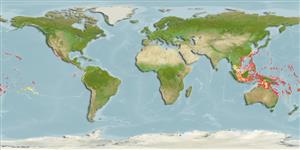>
Gobiiformes (Gobies) >
Gobiidae (Gobies) > Gobiinae
Etymology: Eviota: No etymology given, suggested by Christopher Scharpt: from Latin 'eu' for 'true' and 'iota' for anything very small, in combination 'truly very small' referring to it as being the smallest vertebrate at the time it has benn described by Jenkins (thus, making the suggestion by Scharpt plausible..
More on authors: Jordan & Seale.
Environment: milieu / climate zone / depth range / distribution range
Sinh thái học
Biển Cùng sống ở rạn san hô; Mức độ sâu 0 - 40 m (Ref. 107299). Tropical; 30°N - 30°S
Western Pacific: Japan (Ryukyu and Ogasawara islands), Taiwan, the Philippines and south to Australia and Norfolk Is.; east to Vanuatu, Fiji, Wallis and Futuna, Tonga and Samoa, including Palau, Guam and Marshall Islands in Micronesia.
Bộ gần gũi / Khối lượng (Trọng lượng) / Age
Maturity: Lm ? range ? - ? cm
Max length : 2.3 cm SL con đực/không giới tính; (Ref. 1602)
Short description
Khóa để định loại | Hình thái học | Sinh trắc học
Các tia vây lưng cứng (tổng cộng) : 7; Các vây lưng mềm (tổng cộng) : 8 - 9; Tia cứng vây hậu môn: 1; Tia mềm vây hậu môn: 7 - 8. This species is distinguished by the following characters: complete cephalic sensory-canal pore system (pattern 1); the fifth pelvic-fin ray 10-40% (usually 20%) of fourth ray; some pectoral-fin rays are branched; dorsal/anal-fin formula 9/8; presence of a prominent occipital spot; dorsal midline of body with a series of small dark spots along the dorsal-fin bases; dark bars present crossing the nape in advance of dorsal fin; caudal-peduncle depth 13.4-14.9% SL (Ref. 107299).
Inhabits shallow waters, often including tide pools of exposed seaward reefs (Ref. 37816, 116739), usually in high-tide splash zones and at shallow depths (Ref. 107299).
Life cycle and mating behavior
Maturities | Sự tái sinh sản | Spawnings | Egg(s) | Fecundities | Ấu trùng
Myers, R.F., 1991. Micronesian reef fishes. Second Ed. Coral Graphics, Barrigada, Guam. 298 p. (Ref. 1602)
IUCN Red List Status (Ref. 130435)
Threat to humans
Harmless
Human uses
Các nghề cá: không ích lợi (thú vị)
Các công cụ
Special reports
Download XML
Các nguồn internet
Estimates based on models
Preferred temperature (Ref.
123201): 24.7 - 29.3, mean 28.3 °C (based on 1537 cells).
Phylogenetic diversity index (Ref.
82804): PD
50 = 0.5000 [Uniqueness, from 0.5 = low to 2.0 = high].
Bayesian length-weight: a=0.01023 (0.00477 - 0.02194), b=3.02 (2.84 - 3.20), in cm total length, based on LWR estimates for this (Sub)family-body shape (Ref.
93245).
Mức dinh dưỡng (Ref.
69278): 3.1 ±0.3 se; based on size and trophs of closest relatives
Thích nghi nhanh (Ref.
120179): Chiêù cao, thời gian nhân đôi của chủng quần tối thiểu là dưới 15 tháng (Preliminary K or Fecundity.).
Fishing Vulnerability (Ref.
59153): Low vulnerability (10 of 100).
Nutrients (Ref.
124155): Calcium = 374 [160, 1,182] mg/100g; Iron = 1.74 [0.76, 3.78] mg/100g; Protein = 18 [16, 20] %; Omega3 = 0.175 [0.057, 0.516] g/100g; Selenium = 33.1 [10.6, 89.5] μg/100g; VitaminA = 121 [25, 572] μg/100g; Zinc = 4.49 [2.47, 7.46] mg/100g (wet weight);
